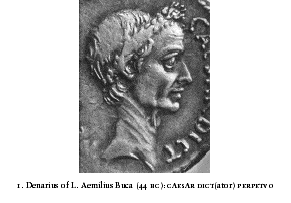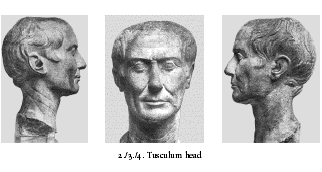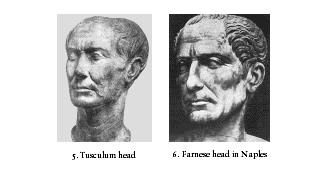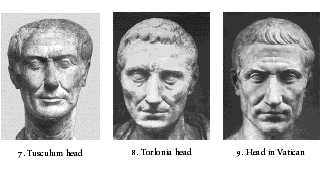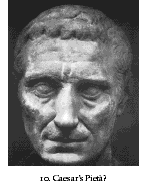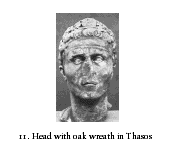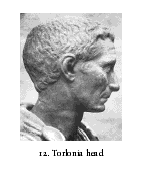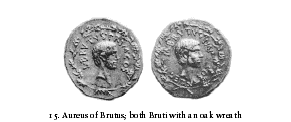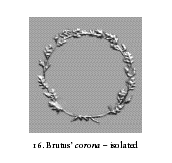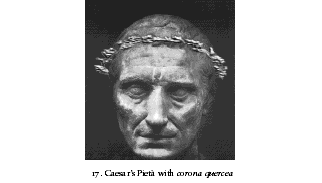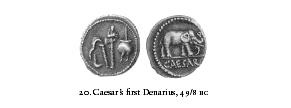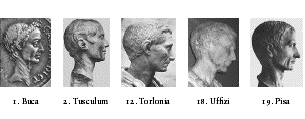Chapter I of the English edition
© Francesco Carotta, Kirchzarten, Germany
© 2005, Uitgeverij Aspekt b.v., Soesterberg, The Nederlands
| back to contents / previous | |||||
|
__________________________________ Prima Vista
This is how Caesar is supposed to have looked[1] before
his murder: weakened by fatigue but somehow spiritualized because of
it, nearly transfigured. Here is a man of vision, of willpower
and—with subtle irony—also a man of clementia. Already he has entered into another realm of existence. The legend on the coin reads dictator perpetuo, but what we are shown is Divus Iulius. The dictator was the first Roman to whom the Senate granted the right to have his image minted on coins, and it happened only a few weeks before his death. In the view of the attitudes of the time this constituted a superhuman honor. While Caesar posed for him, the minter must have felt the god in his presence. Now famous, a marble bust from Tusculum (cf.ill. 1./2./3.) has been identified as that of Caesar[2]by the typical saddle of the crown accentuated by the bold forehead, the angular jawline, the ‘vulturine’ neck, and—last but not least—by the ironic lines of the mouth. Here is the same vision and will, but the clementia is more concealed by a stronger sense of irony. One can see the ruler of the world advancing, and sense there is a claiming of ownership, and an inaccessibility. Before us is the Caesar of veni vidi vici.
In fact, this head could have been fashioned up to two years before the above coins were struck, because in the time between 46 and 44 BC a number of statues were consecrated to Caesar in Italy.[3] In this case too, the sculptor for whom Caesar posed was obviously not unimpressed. This marble head itself became a model for later statues during the time of the emperors, as can be seen here by its juxtaposition with the colossal head in the Farnese collection:
Moreover, this head from Tusculum has given rise to a conjecture regarding another head in the Torlonia museum, which fascinates the researchers and leaves them divided: namely, is this his real face, or the face that met the expectations of the time? The features are the same except for the direction of the eyebrows, but the expression is completely different. This head seems to have had some influence on the later statues of Caesar, ones in which the Clementia was accentuated as it is with the head in the Vatican. For comparison, below we have set the head in the Torlonia museum between the Tusculum and the Vatican heads:
We can easily see that the latter two heads were made after the death of Caesar, as piety has restored his hair and his head shape conforms to an ideal. But how long after Caesar’s death did this take place? We know that the head in the Vatican originates from the Augustan period, but for the Torlonia head the facts are still contested. Some assign this particular specimen to the Claudian period, but they do not rule out a connection with a contemporary genesis.[4] Others think that it is an original, made shortly after Caesar’s death. Now, whether it be original or a copy of an original, the hypothesis has been proposed that this kindly face, deeply etched by suffering, yet of such strong willed countenance—an expression quite singular in the iconography of Caesar—belonged to the statue erected by Marcus Antonius on the Rostra after Caesar’s murder. According to a letter of Cicero[5] it bore the legend: parenti optime merito. It was to awaken feelings of both pity and revenge in the observer.[6] If true, we would thus be standing before the Pietà of Caesar. The question of whether Caesar himself had acted as a model to the sculptor is not rendered superfluous by the fact that he was already dead. Because at his funeral a wax figure had been made of him precisely for this occasion and placed on the Rostra by Marcus Antonius.[7] Possibly a mold of the face of the deceased Caesar had been taken for this event, and was employed again later when the statues were made. The fact that the lines are those of Caesar, but not the expression, could indicate that it was a death mask of the deceased. It follows, too, that the shape of the head would be different because the mold would only have been taken of the face.
Then it would indeed be Caesar’s Pietà.[8] In any event, it is a fact that a statue of Caesar had already been placed on the Rostra during his lifetime, for all the ancient writers substantiate it. It was part of the honors granted him after the battle of Munda, his final victory over the Pompeians. Cassius Dio even speaks of two statues: ‘And they also set up two
statues of him on the Rostra, one representing him as the Savior of the
citizens and the other as the Deliverer of the city from siege, both
wearing the customary wreaths for those achievements.’[9] One wreath was the corona civica—the ‘citizen’s crown’—made from oak leaves: those who were saved owed this to the one who had saved them. The other wreath was the corona obsidionalis—the ‘siege crown’—braided of the grass growing in the fields where the besieged had been surrounded. This wreath was presented to the field general who had freed them.[10] When Antonius, in early October 44, ordered the erection of the statue that we are now interested in, the other statues that had previously stood on the Rostra had already been toppled and destroyed in the disturbances after Caesar’s death.[11] The one rededicated by Antonius would have replaced one of these, and to replace the second statue one was probably set up on Octavianus’ column.[12] We have to imagine the above-mentioned pietà head crowned with one of these two wreaths, either of oak leaves or grass. These statues of Caesar wearing the oak crown were not only in Rome but were to be found throughout the whole empire. This was because, by dint of ancient custom, each individual saved by Caesar owed him a wreath of oak leaves. And in the course of that murderous worldwide civil war, was there anyone he had not saved? He had saved his own followers from being massacred by the enemy, on the battlefield he had spared the defeated enemy and protected them from falling victim to the rage of blind wrath or revenge. He defended them personally and even physically. Indeed, he even saved them politically by restoring them to their positions and ranks. A corresponding decree by the Senate helped to convince the ungrateful. The inscriptions on the pediments of the numerous statues dedicated to Caesar that have survived, especially in the East, bear titles not only such as pontifex maximus, dictator or consul, but also sôtêr, euergetês, patrôn, theos—savior, benefactor, patron, god, etc.[13] Unfortunately, the statues that belonged to these pediments have not been preserved—except for one head, found in Thasos and exhibited in the local museum.[14] It is heavily damaged and weather-beaten, but the features must have been very approximate at best, even when it was first made. In the East they were not accustomed to the same realism as in Rome. And, for images of a god, the features do not have to be realistic, but rather conform to an ideal model.
The oak wreath etched into the marble is plain to see, and it is also reminiscent of later depictions of emperors such as Augustus or Vespasianus. But engraving the oak wreath into the marble was not the original custom. Originally he who was saved was responsible for ensuring that his savior was always provided with a wreath of fresh leaves. And the savior really wore it. Because of the zeal of his followers,[15] Caesar’s statue in Rome would certainly not have lacked fresh wreaths.[15b] If a weatherproof wreath were needed, one of metal would be provided. Indeed, if we look at the Torlonia head in profile especially towards the back of the neck, we plainly see a raised arch where the wreath would have sat:
Now what did the pietà look like with an oak wreath? With which oak wreath was it crowned and from which oak? The shape was in fact not uniform, nor even was the way in which it was worn, as is demonstrated by the statues and coins of later emperors decorated with such wreaths. And the wreath on Caesar’s head depicted on coins is never an oak wreath, but rather a triumphal wreath—the so-called laurel[16] or more precisely a golden copy based on an Etruscan design, the corona aurea. [17] To Caesar, the oak wreath was the more sacred one. He earned his first as a young man serving in combat during the conquest of Mytilene. And if the confirmed partisan of Sulla, M. Minucius Thermus—the governor of Asia for whom Caesar served as a military officer—awarded the corona civica to the nephew of Marius who had been prosecuted by Sulla, then it is very probable that Caesar had earned it indeed, having physically saved the lives of Roman citizens in battle.[18] This finally opened up the political career of Caesar, who had been under proscription until then, hunted by pursuers and not allowed to exercise his office as flamen Dialis (high priest of Jupiter). But his career was to remain ever controversial and contentious. After his victory over Pompeius and the Senatorial party at Pharsalos in 48, he ordered that his oak wreath should finally appear on coins, but it was not placed on his head, but on that of Venus, his divine ancestress.[19] On the reverse of these denarii we see a tropaeum with Gallic weapons, along with an axe (ill. 13) or a prisoner (ill. 14). Beneath the tropaeum, or with it in a cross formation, is his name: CAESAR. The message was clear: he had freed all Romans from the ancestral threat of the Gauls, so now all Roman citizens owed their lives to him. But doubly indebted were those who, instead of being grateful, had tried to rob him and his legionaries of their triumph and the rewards due them for their grueling nine-year long campaign. His enemies had wanted the war, but now, defeated, they had to rely on his grace and consider themselves lucky that Venus Genetrix, mother Venus, was nevertheless still so peace loving and merciful.
And just to make it clear who it was symbolized by the head of Venus, he had added his age, LII – 52, on the other side precisely where Cupid appeared in the same series.[20] A new era had begun,[21] and all of the people could now start celebrating the birthday of their savior, and of their parens, who had given them the gift of life. But it is well known how they carried out their duty: they waited a long time until the opportunity finally arose—and they murdered him. And then the oak wreath promptly migrated to another head—that of Brutus. Interestingly, the depiction of this oak wreath with its totally different meaning in the year 42 has been passed down to us in near perfect condition. That is because this murderer of Caesar immortalized his deed on a gold coin.[22]
On one side is depicted the ancient Brutus who had driven the last kings out of town (509 BC), on the other side he himself—the new Brutus—who, emulating his ancestor, had freed the city and the world of the new king Caesar. Hence the reasoning for the oak wreaths: both Bruti had saved every single citizen from tyranny, even from death, because a life by Caesar’s grace was the death of a free citizen—at least in Brutus’ thinking. And nobody knew this better than he himself, for he was exactly in that situation. Although ever favoured and protected by Caesar (there were rumors that this occurred for his mother Servilia’s sake, and the talk of the town was that he even was Caesar’s son), Brutus fought on the side of his uncle Cato in the civil war against Caesar. Then, among the defeated at Pharsalos, he was pardoned by Caesar and even taken into his circle of friends and assisted in a further career. Now the prodigal son had murdered such a tyrant. His gold coins propagated the idea that he, Brutus, was the true savior of the citizens, not Caesar. Accordingly, his coins bore the same wreath as had Venus on Caesar’s coins, and as the statue of Caesar did in Rome and throughout the empire. Isolated, Brutus’ wreath looks like this:
It seems to be made out of quercus ilex with its small and pointed leaves. We are still in the pre-Augustan period, and so this wreath too, like that of Caesar’s Venus, has a graceful, Hellenistic look. If we set it upon the Torlonia head with the help of computer graphics we obtain this result: The Torlonia head now looks very much like an image of Jesus with his crown of thorns.
Unfortunately it is not possible for us to repeat the same visual experiment with the other wreath, the one of grass which adorned the second statue that was erected on the Rostra (see above), because no definite representations of the corona obsidionalis have been passed down to us.[23] The name, corona graminea, suggests that the grass wreath was very probably made from couch grass, because the name graminea means couch grass both in the Romance languages and in botanical terminology. And a wreath made of Mediterranean couch grass would awaken associations with a crown of thorns for sure.[24] Caesar’s iconography seems
to anticipate a motif central to that of the Christ: in the
representation of the suffering and tortured man who overcomes his own
death, who by passing through death becomes God. The resemblance between Caesar’s grass wreath and Jesus’ crown of thorns may be a coincidence:[25] who did not wear wreaths in classical antiquity! But the fact that a statue of Caesar may have had the appearance of a pietà, before which, if it were positioned in a church each little old lady would make the sign of the cross, makes one ponder. Moreover, the inscription on the base—Parenti Optime Merito, ‘to the most meritorious parent’—reads like a replica of that found on the temple of Jupiter—(D)iovi(Patri) Optimo Maximo, ‘to the Father God (Jupiter) best and greatest’ and which is still to be seen on our churches in the abbreviated form DOM (Deo Optimo Maximo), ‘to the best, highest God’. On the other hand, the acronym POM could be read as Pontifici Opltimo Maximo: which only seems to be an understatement. Because the office and dignity of pontifex maximus had been Caesar’s sheet anchor and was a decisive source of power during the beginning phase of the civil war. With the conclusion of his prolonged Gallic proconsulate at the end of the year 50 BC, Caesar no longer held Republican office. His candidature in absentia for the consulate of 49 BC, was impeded by the hostility of the Senatorial party and the about-face of Pompeius. He divided the Senate with the clever offer to lay down his command if Pompeius did the same. By doing this he made it possible for his opponents to declare him an enemy of the state only if they violated the intercession rights of the tribunes who advocated for him and for the peace. It was exactly this issue that brought him into the arena as pontifex maximus, because the tribunes of the people were sacrosanct, and there was a grave historical precedent. In 133 BC it was just such a people’s tribune, Tiberius Gracchus, who had lost his life as a consequence of the violation of the tribune’s power of intercessio or ‘veto’. Another tribune, M. Octavius, bribed by the landed gentry of the Senate, hindered the approval of a people-friendly land law by using his power of intercessio and was subsequently removed from office by the people’s assembly on Tiberius’ order. The people indeed had the right to remove a tribune of the people from office if he misused his intercessio power with the aim of betraying his party. Nevertheless, at the next best opportunity, when Tiberius stood for re-election as a tribune of the people, the then pontifex maximus Scipio Nasica blamed him for violating the constitution. He called for a lynch mob and led the pack of senators who slew Tiberius and 300 of his followers on the Capitol hill and threw their bodies into the Tiber. This mass murder was never expiated. On the contrary, ten years later it was repeated on Tiberius’ brother Gaius and 3000 of his followers in an even more bloody manner. This massacre of a tribune of the people—with the blessings of a pontifex maximus—had been the spark that 80 years earlier ignited the civil wars which were a murderous struggle for control of the land. So, remembering the fate of the Gracchi, the tribunes of the people for 50 and 49, Curio and Antonius, fled under threat to their lives to find Caesar in Ravenna on the other side of the Rubicon, awaiting the result of the negotiations. He too, like Tiberius in days of yore, was impeded in his re-election because of an alleged violation of the constitution, but this time he was the pontifex maximus. This time it was not an Optimate but a Populare who now held the authority to intervene in the dead-end political stalemate as the highest priest and custodian of the constitution. This time, with his loyal army, tested in battle, he had the power to do so, and as his veterans were awaiting their dues in the form of land allotments, it was even his duty to do so. Caesar realized that the sacred dignity of the pontifex maximus would be decisive, just as it had been in the time of Tiberius and M. Octavius, only this time under reverse conditions. So he dared to throw the dice over the Rubicon. The fortunate result of that venture made a god out of the pontifex maximus. The first of all his coins, the denarius that he had struck while possibly still in Gallia Cisalpina, shows the theological dimension which the political and military conflict had from the beginning. Contrary to what we would expect, the elephant was depicted on the reverse, rather than the obverse side of the coin. One can realize this by the fact that the name CAESAR is always found on the reverse of all the other coins,[26] likewise the theme—the victory over Gaul. The ‘dragon’ which the elephant is stamping on is a carnyx, a typical Gallic horn; ‘Caesar’ was said to mean elephant in the Punic language,[27] and perhaps Caesar was called that by the Gauls, who had come to know the elephant through Hannibal. This latter had invaded Italy at that time not only with his elephants, but with his Gallic allies as well.
Caesar presented himself on his coin as the one who had finally defeated the Gauls. However, he had recruited in Gaul, his best legionaries were Gauls, his cavalry Germans. So inevitably he was seen as a new Hannibal, who invaded Italy at the head of a Gallic army. Now, at the beginning of the civil war, this apparently suited him very well: it raised the level of deterrence.[28] But the most interesting aspect of this first—programmatic—coin of Caesar is what is missing: the head of a god. Not his Venus, not Jupiter, nor the Saturn of the Pompeians are to be found on the obverse as tradition would have demanded, but rather the insignia of the highest priest. Here, by this means, the pontifex maximus takes the place of a god. This undoubtedly suited the Epicurean Caesar because the pontifex maximus was literally ‘godless’. Each flamen had his own god, the flamen Dialis Jupiter, the flamen Martialis Mars, the flamen Quirinalis Romulus Quirinus, the sacerdos Vestalis Vesta, etc. Only the pontifex maximus had none, and that was why he had the power to supervise pontifices, flamines and vestals—to stand in the place of each and all of them—and if necessary chastise them as well. He who was godless was the highest priest of all the gods and of the Deity in general. With Caesar this godless priest took the place of God. Consequently, it was in the inscriptions on the statues dedicated to him in Ionia after the victory of Pharsalos where he was first entitled pontifex maximus. The additional titles of dictator or consul, sôtêr, savior, or euergetês, benefactor, may or may not have appeared. Pontifex maximus, in Greek archiereus, or respectively archiereus megistos,[29] always appeared right up front. And on the rare occasions when it did not appear, it was substituted with theos[30]—god—the Greek translation of the Latin divus—which Caesar had chosen for himself instead of deus—an antiquated variant which was closer to Dieus, the old name of Jupiter or more respectively Zeus. Sometimes the inscription read theos epiphanês, the ‘appearing God, coming to light’, which accentuated the proximity to Jupiter’s sphere. And thus the pontifex maximus became divus. There was no problem with this in Ionia, where the people were used to greeting and praying to their Hellenistic rulers as gods. As Alexander had risen to the status of Amon-Zeus, so too were the succeeding houses of the Diadochs considered dynasties of gods. Now a Roman had taken their place: the new ruler was the new god. Not an epigone, but rather a new Alexander: as he had been identified with Zeus, so now was Caesar with Jupiter—change within continuity. Yet in Rome, the city that took pride in murdering kings as tyrants and driving them out—beginning with Romulus and Tarquinius—Caesar was murdered as being just such a one. So the title divus was suspended as well. But even the murderers of the tyrant could not prevent the funeral of the pontifex maximus which the furor populi transformed into his apotheosis. This inspired Antonius with the hope that his —who had been Divus Iulius from the time of his youth—could soon be raised to become a new Jupiter. Soon. But for the moment, in the face of the Senatorial support for Caesar’s murderers, not the least of which was Cicero’s, the allusion had to suffice.[31] In order to give the statue and its inscription telic force, Antonius put the word parenti at the beginning. This was a direct reference to the title parens patriae—parent of the native city, (pro)creator of the empire—which was finally conferred on Caesar and also appeared on his latest coins. With that title, the patres had finally acknowledged their own parens, and obligated themselves to protect with their lives the life of the one who had saved them. In response, Caesar had dismissed his Spanish bodyguard—and then his enemies murdered him. Because they had not been successful in damning Caesar as a tyrant, the title parens only waited in a state of abeyance, eventually offering the leverage to expose Caesar’s murderers as parricides. This would kindle the hatred of the people against them, along with the wrath of the furies. There was no escape. This was very clear to Cicero.[32] Cicero had been given the title pater patriae because he had ordered the Catilinarians to be executed without trial, making him the spiritual mentor of those patres who had now killed Caesar. When he wrote to Cassius that the choice of this word parenti not only made them all assassins, but parricides as well, Cicero was still playing things down, because it in fact even made them matricides. By selecting the word parens, ‘parent, parturient, procreator’, instead of pater, ‘father’, the martyred son became fused with the mother Venus. So not only was the putative fatherhood of the ruler referred to, but also the primary, creative parenthood that Caesar’s acts had manifested, for he had not only governed the empire, he had created it first. It was into this empire that he had led his veterans, settling them in the rural cities that he had established: Horace calls him pater urbium—father of the cities.[33] Appearing on the colonial coins throughout the whole empire were the words: parens, parent, conditor, founder, or simply creator.[34] For his veterans he was father and mother, and between the two, more mother than father, for they knew his love for them, his indulgence and his care. In this sense the word parenti on Antonius’ statue was directed at the pietas, the filial love of the veterans. Optime meritus: the one who had merited the most, whose emeriti, as his discharged soldiers, they were. Now, if those who called themselves optimates, considering themselves to be the very best, murdered the optime meritus, then what on earth could his emeriti—his veterans—expect from them? What might happen to the promised land allotments? Did not Brutus want to use the public purse to compensate the landed gentry—who considered the state acres as their own—so that they could buy back the allotments of the veterans? Were the veterans to become landless once more? So, there was only one hope left to the large numbers of veterans in the city, waiting for the confirmation of their land grants: to be led into war against the murderers of their ‘parent’, their creator, so that they might exact cruel revenge on them and elevate Caesar to the highest god, the heavenly guarantor of his and their empire on earth—Divus Iulius, their god—who was, for them, more of a Venus Genetrix than a Jupiter. And so they were more than receptive to the plans of Antonius, whose word carried authoritative weight with them. He had been the right arm of Caesar, and by the time of the erection of the above mentioned statue, he was not only consul but the designated flamen Divi Iulii, the predestined high priest of the new god. Even if one assumes that he was not inaugurated yet,[35] he was nevertheless appointed flamen to Caesar whilst Caesar was still living.[36] Therefore the statue erected by Antonius on the Rostra was not only political propaganda, but the first cult statue of the new empire’s god. If it was the column mentioned by Suetonius that served as its pediment—and the first word of the inscription, parenti, lends itself to this assumption—then it was the object of a real cult. ‘Later the people erected on the Forum a massive column of Numidian marble, nearly twenty feet high, with the inscription parenti patriae, ‘to the parent of the fatherland’. And for a long time afterwards they used to offer sacrifices at the foot of this, make vows there and settle disputes by oaths taken in Caesar’s name.[37] Precisely because the statue
remained without an official character, but rather had only a partisan
one, it was all the more effectively designed. As is known, it did not
fail to have the desired effect. The coalition against Caesar’s
enemies successfully formed: Cicero was murdered in 43, and Brutus and
Cassius, being defeated in 42 in Philippi, killed themselves. Caesar
could finally be consecrated as Divus Iulius, and thus his
improvised apotheosis—which had been enforced at his funeral by
the people, enraged at his assassination—was later legitimized.
He had been victorious over death and achieved his elevation to the
gods posthumously. The ‘evil spirit’ that the dead Caesar
turned into for his assassins—appearing to Brutus again in
Philippi and forcing Cassius to kill himself with the same dagger he
used against Caesar—was raised to the heavens as a god, like a
new Romulus Quirinus.[38] Caesar’s statue of 44 demanded just that. Different than those in Ionia, the inscription here is Latin. But we can easily imagine how it would have sounded to the ears of Greek-speaking Romans, and there were many of them. At this time they made up more than half of the empire’s population, especially in the capital.[39] Not only officers, entrepreneurs, technicians, merchants, publicans, scholars, pedagogues, physicians, lawyers, priests, actors etc., but there were also the Greek-speaking veterans themselves, those from the East and those from the West who participated in the Eastern campaigns. It should be observed that linguistically, parens, ‘parent’ or ‘father’ and creator, in the sense of ‘founder’ especially a ‘founder of cities’, is called ktistês by the Greeks, while optimus is usually rendered aristos—both translations are well documented, additionally on Roman imperial coins in the East. Conversely, the words meritus, ‘meritorious’, as well as bonus, ‘good’—whereby optimus, ‘the best’, is an intensification—can in this sense be appropriately translated by the Greek word chrêstos, a word whose classical pronunciation was already becoming replaced by the late Hellenistic christos, which is still used today.[40] Hence, on the base of the first cult-statue of the new god Caesar, the Greek speaking people read that the divine founder of the empire was optime meritus which meant for them chrêstos, respectively christos. This would not surprise them, because they were used to addressing their deceased on epitaphs with chrêste,[41] ‘good’. For Caesar the word fit perfectly, because he was ‘good’: proven by his much acclaimed clemency. Indeed, the defeated Pompeius had called upon his followers to reconcile themselves to the stronger Caesar because he would be well-disposed and ‘good’: chrêstos.[42] Parens, optimus, meritus—ktistês, aristos, chrêstos. Three words, each of them (the last one is very telling) resembling in appearance and pronunciation that of another word, christos, ‘anointed’, which later emerged as the title of Jesus.[43] The possibility of confusing chrêstos with christos was so easy and natural, that the spelling with an ‘ê’ instead of an ‘i’ is still to be found in some writings of the Classics (for example Tacitus’ chrestiani which was changed to chrestiani, or Suetonius’ chresto as well, interpreted by some as Christus) and also in the New Testament in various places. But this happened later, in another context. For the moment, nobody would have gained anything by a possible confusion of chrêstos, ‘meritorious’, with christos, ‘anointed’, nor would they have taken offence, because both high priests and kings were anointed, and Caesar had been both at once—the first in very fact, the second by reputation. Moreover, as chance would have it, christos also looks like an abbreviation of archiereus megistos, the Greek form of pontifex maximus, the first earthly title of their God. Christos indeed looks like a contraction of archiereus megistos, no farther removed from each other as e. g. Köln from Colonia, Lyon from Lugdunum, Zaragoza from Caesaraugusta, Bizerte from Hippo Diarrhytus or priest from presbyteros. The letters surviving the contraction are here visually demonstrated by capitals:[44] arCHieReus megISTOS > CHieRISTOS > CHRISTOS. Furthermore, the word christos regularly is found abbreviated in Christian writings, sometimes with both first initials of XPICTOC, X and P, written one over the other in form of a monogram. And this is not so far away from the initials of pontifex maximus, P and M: MP respectively XP. If the approximate resemblance of christos with ktistês, aristos or chrêstos is purely coincidental, christos is not at all an accidental contractional form of archiereus megistos but an inherent one. If the title was used in prayer—and that can be inferred from the fact that this appellation ranks first on all the base inscriptions of his votive statues—then this long title would inevitably have contracted by its perpetual formulaic repetition. All this makes one wonder: Caesar’s statue not only looked like a pietà, but the inscription on the base also evoked the Christ. Is this air of familiarity, that we have detected in the iconography and the titles of Caesar and Jesus respectively, merely coincidental or does it indicate a relationship of dependence? As Caesar was born exactly a century before Christ and the above-mentioned statues and inscriptions on the bases are from the year 48 respectively 44 before Christ, then a dependent relationship can only point in one direction: Christ would not only have been born after Caesar, but also created after him. In order to examine this, we need to place Caesar’s history and the Gospel side by side and see if further resemblances occur, and if so, whether they indicate mere borrowing or infer real filiation. New ground is being broken. We will begin—so we can avoid becoming quickly lost in the details—by scanning the terrain from a bird’s eye view, detecting the rough outlines at first, and then in the second phase we will dig into the texts for further proof. We have selected a task that is accomplishable. Just as there are different Gospels preserved for us, so there are also different histories of Caesar. We can choose as our strategy a comparative analysis. This method has an additional advantage. If aerial photos reveal that the two shapes do not show the same contours—are not congruent—we would already have come to a result, even if a negative one. There is no need to project. And because we do not have to approach this reductively, there is no need to engage in the ticklish methodological questions involved in the search for the historical Jesus either, at least not initially. We can come straight to the point. __________ These notes aspire neither to completeness nor to the naming of the first respective originator of a thought or a theory. Since this work is more a research report than an academic treatise, such aspirations would actually be neither required nor useful. However, should we have violated any rights of primogeniture, this did not happen intentionally and we hereby apologize beforehand, and promise to mend our ways. We also would like to express our gratitude in advance for any references, tips, or clues sent to us. For abbreviations of collected editions and lexicons, journals and serials, monographs and terms see Ziegler & Sontheimer (1979). For the Greek authors’ names and titles see Liddell & Scott (1996) and for the Latin ones Glare (1996).The Gospel texts translated into English were quoted on the basis of the King James Version of 1611. In some cases the Revised Standard Version of 1881 and the New American Bible of 1970
were relied on. These three translations often differ from each other
considerably. Although they all, even the Catholic one, make use of the
original languages rather than the Vulgate as a basis for translation,
they have the tendency to read the text of the New Testament according
to the current interpretation and to amalgamate it with the Old, so
that in critical points the newer translations are overtly conflicting
with the Greek original text, arbitrarily interpreting e. g. thalassa, properly ‘sea’, as lake, Christos, ‘Christ’, as Messiah, adapting the orthography of the proper names in the New Testament to those in the Old, e. g. Elias to Elijah,
etc. For this reason we have prefered to use as a basis the King James
Version, which is older but more reliable and closer to the Graeca Veritas. Notes to I. Prima Vista [ if the Greek text on your browser does not appear correctly, please refer to the printed edition or to the PDF of the notes ] [1] According to Lange (1938) this Buca-denarius (collection Mamroth, Berlin-Pankow) represents the definitive Caesar-portrait. The same coin is depicted on the cover of various books, for example in Gelzer ( 3 1941) and Vandenberg (1986). A. Alföldi analyzes in the Schweizer Münzblätter 73, 1969, p. 1-7 ‘the earliest type of denarius by L. Buca with the inscription caesar dictator perpetvo ’, from which it can be learned that this denarius belongs to one of the earliest types (plate 1, 1-3 ). Similar features are also found on the Mettius-denarius with caesar dict qvart (B.M.C. 4135 , Crawford 480/2a-b); since dict qvart preceded dict perpetvo for some time, this Mettius-type would be the more original (cf. A. Alföldi , ‘Das wahre Gesicht Caesars’, Antike Kunst 2, 1959, p. 27 sqq). It can be seen that later dies idealize towards clementia and divus, so that some Buca-denarii (as the denarius depicted here or the one in A. Alföldi , Schweizer Münzblätter 73, l. c. plate i, 3 ) already show ‘Jesus-like’ features. For the whole of this iconography cf. R. Herbig, ‘Neue Studien zur Ikonographie des Gaius Iulius Caesar’, first published in: Kölner Jahrbuch für Früh- und Vorgeschichte, Berlin, 41959, p. 7 sqq., and again in: D. Rasmussen ed., Caesar, Darmstadt 1967 , with bibliography and many illustrations. [<] [2] Borda (1957). [<] [3] Vessberg ( 1941) , p. 176 sq. [<] [4] So Borda, l. c. [<] [5] Cic. Ep. ad fam. 12 . 3 . [<] [6] Erika Simon, Arch. Anz. 1952, 138 sqq.; Gymnasium, 64 . Jg., 1957, H. 4, p. 295 - 9 . [<] [7] App. BC 2.147 [<] [8] The identification of the Torlonia head as a Caesar-portrait was questioned by Paul Zanker, Arch. Anz. 1981, p. 357
. He suspects a ‘Caesar-Zeitgesicht’, a ‘time-face of
Caesar’, i. e. the portrait of an unknown person amongst the
leaders of a provincial town, in which ‘the effect of the
numerous statues to the honor of the divine dictator are
reflected’. He thinks that Erika Simon’s
‘interpretation of it as a pity rousing, posthumous figure, which
has found a very positive echo in the newer literature’ is based
on ‘empathy’—and rejects it: ‘In spite of great
resemblances, mainly in the details of the nose and the mouth, in the
accentuated cheek-bones and the structure of the forehead, the head
differs clearly in the proportions and the profile from the authentic
figures of Caesar of the Turin type (from Tusculum) and the
Pisa-Vatican type.’
Apart from the fact that the typical occiput of Caesar seems
to be more accentuated than usual and so the neck has become somewhat
thicker to accommodate this, we can find no major differences. That the
saddle in the middle of the forehead has been rounded and the hair
piously covers the bald front in the heads Torlonia, Uffizi and Pisa
marks them all three as posthumous. Only the expression of the
Torlonia-face is different, more humble, stressed by the inclination of
the head. But the same expression and the same inclination of the head
are also found in that of the Palazzo degli Uffizi (as well as in the
Vatican-type, see chapter 1 ill. 9). [9] Dio Cass. HR 44.4.5 : καὶ ἐπί γε τοῦ βήματος δύο (ἀνδριάνταϛ), τὸν μὲν ὡς τοὺς πολίτας σεσωκότος τὸν δὲ ὡς τὴν πόλιν ἐκ πολιορκίας ἐξῃρημένου, μετὰ τῶν στεφάνων τῶν ἐπὶ τοῖς τοιούτοις νενομισμένων ἱδρύσαντο. [<] [10] Gel. 5.6.11 : civica corona appellatur, quam civis civi, a quo in proelio servatus est, testem vitae salutisque perceptae dat. ea fit e fronde quernea; 5.6.8: obsidionalis est, quam ii qui liberati obsidione sunt dant ei duci qui liberavit. ea corona graminea est, observarique solitum ut fieret e gramine, quod in eo loco gnatum esset, intra quem clausi erant qui obsidebantur. [<] [11] App. BC 3.3.8 [<] [12] Cf. Weinstock (1971) , p. 365 . [<] [13] Details cf. Raubitschek (1954), p. 65-75 ; Die Inschriften von Ephesos (The inscriptions of Ephesos), part II, 1979, nº 251 . [<] [14] Photography: Deutsches Archäologisches Institut, Rome. Cf. F. Chamoux, Fondation Eugène Piot, Monuments et Mémoires 47, 1953, 131 sqq. Tab. 12 . [<] [15] Cf. App. BC 3.3.8-9 ; Cic. Phil. 1.5 . [<] [15b] Even today, more than 2000 years later, there are always daily fresh flowers on the place of Caesar’s pyre in Rome. [<]
[16] Sometimes also a wreath of myrtle is supposed, cf. L. Cesano, Rendiconti della Pontif. Accad. Rom. Archeol. 23/24, 1947/49, p. 146 sqq., and Kraft (1969) , p. 21 and n. 78 : ‘könnte man sie auch als Myrtenblätter ansprechen—they could be called myrtle-leaves as well’. [<] [17] That the wreath was called etrusca corona is attested to by Tert . coron. 27 , and that the instruments which were used in the triumph are of Etruscan origin by App . Pun. 66 (cited after Latte (1960), p. 152 ) . Kraft (1969) , p. 20 : ‘On the coins Caesar certainly does not wear a natural wreath of laurel or another wreath of green leaves, but an Etruscan corona aurea (after Dio Cass. HR 44.6.3 )’, an Old Etruscan royal crown, which he distinguishes from the corona aurea of Pompeius (after Vell. 2.4.40 ). In contrast Crawford (1974), I, p. 488 , n. 1 and nº 426.4 a, who accepts a ‘golden triumphal wreath’, but not an ‘Old Etruscan royal crown’ (he thinks Caesar’s golden triumphal wreath is identical to Pompeius’ corona aurea ). Dio Cassius ( HR 44.6.3 ) speaks of a ‘wreath, embroided with gold and decorated with precious jewels’—καὶ τὸν στέφανον τὸν διάλιθον καὶ διάχρυσον. [<] [18] Lucius Cornelius Sulla was the
leader of the senate party (the optimates), Gaius Marius of the
people’s party (the populares). M. Minucius Thermus was an
obdurate follower of Sulla who in 88 chased Marius, an uncle of
Caesar’s, out of Rome. [19] The sign on the left behind the head of Venus is generally regarded as an ancient form of writing for LII (52) and is interpreted as Caesar’s age: born 100 BC, so in 48 BC at Pharsalos he was 52 years old. The female bust is identified as Venus, but by some authors as Pietas. This is explained by the argument that the oak-wreath is not an attribute of Venus, but that it is an act of pietas to save the lives of citizens (for the discussion cf. Battenberg, p. 37 sq). On the other hand—Caesar’s Venus was not typical: he had not consecrated the temple at the Forum Iulium to Venus generally but to Venus Genetrix. So the relationship between the one saved and the savior was a relation of pietas, because the one saved owed his life to his savior, who was then like father and mother for him. Therefore Venus cannot really have attributes of Pietas, whereas Venus Genetrix indeed can. [<] [20] Cf. Crawford nº 468/1. Obv. : Bust of Venus with diadem, with Cupid in the background. Rev. : Tropaeum with Gallic arms and carnyces. At the base there is a seated female figure, on the other side a bearded Gaul with hands fastened behind the back. Below the inscription: CAESAR. [<] [21] Indeed the cities of Asia started to date the time after Pharsalos (see below and cf. inter alia Leschhorn (1993),
p. 221 sqq). But apparently for Caesar the year of Pharsalos was not
year 1, but the year 52: he reckoned his new era from his year of
birth, 100 BC. The reason for this was perhaps that Pharsalos was
decisive for the East, as Pompeius had reigned there until then. But
for Caesar, the previous year—the Rubicon, Corfinium, Brundisium,
Rome—was the year of his assumption of power. Thus he had no
uniform time reckoning anyway. His year of birth, however, allowed the
connection with Iulus-Aeneas-Venus, the mythical origin from
Ilium/Troja (cf. the coin from the same series Crawford nº 458,
where on the obverse Venus is depicted with a diadem and on the reverse
Aeneas carrying the father Anchises on his shoulder and the palladium
in his hand), which allowed the connection of Italy with Asia and vice
versa. Moreover, by reckoning time from the date of his birth he erased
the time of Sulla (and also that of Pompeius) and connected himself
directly with the time of Marius. [22] B.M.C. East 58 . Cf. Carson (1978) , vol. I, 269 . [<] [23] Whether a corona graminea can be recognized on the face-helmet of Battenberge, respectively a corona obsidionalis on the Italic-Roman pan of earthenware from Teate, is doubtful. Incidentally, they are completely different in their form of appearance. Cf. Kraft (1969), p. 16 , n. 51 . [<] [24] The corona obsidionalis was a decoration of higher distinction than the corona civica, because it represented not only the rescue of a single citizen but of a whole division or even an army. ( Festus 193 M. ( 208 L.): inter obsidionalem et civicam hoc interesse quod altera singularis salutem signum est, altera diversorum civium servatorum; Plinius 22.8: quod
si civicae honos uno aliquo ac vel humillimo cive servato praeclarus
sacerque habetur, quid tandem existimari debet unius virtute servatus
universus exercitus? Liv. 7.37: secundum consulis donationem legiones gramineam coronam obsidialem, clamore donum approbantes, Decio imponunt.
) Accordingly it was awarded extremely rarely, according to Plinius
only seven times in the whole of Roman history (after Caesar only to
Augustus, before him to Sulla; Plin. 22.7-13
). It was given to Caesar not only because of a specific event—of
which there were more than one, the last time in Munda—but also
because he had liberated the city generally from the siege, which means
the Oikumene from the opposition party and the spectre of civil war
(see above, citation of Dio Cassius, cf. Weinstock (1971), p. 148-152 ). [25] The other difference between the
statues of Caesar and those of Jesus concerns hair length and beard. We
noticed a steady increase in hair length for Caesar’s statues
over time. For he suffered from his baldness, ergo little by little
piety gave him back his hair. [26] Cf. Battenberg (1980) , p. 56. [<] [27] Historia Augusta, Ver. 2.3 ; Serv. Aen. 1.286 i. a., compare RE X 464 sq ‘Caesar’ is said to have been the Moorish name of the elephant. As it was claimed the Julii with the cognomen Caesar inherited it from an ancestor who had it conferred on him for killing an elephant (in the first Punic war?). It is possible that the elephant was called Caesar by the Gauls as well, because they got to know the animal not through the Greek (Pyrrhus) but through Hannibal. It is said that Caesar, too, had elephants with him in Gaul and that he even used one in Britain at the Thames (Polyaenus VIII.23.5). Of course there were other explanations of the name ‘Caesar’: a caesis oculis, ‘because of the blue eyes’ (but Caesar’s were black, Suet. Jul. 45 . The cruel Sulla had blue ones, so the reference to the blue eyes—at least in the name—could have been part of the political discrediting campaign); a caesaries, ‘because of the hair’ (but he was bald, so the explanation could be part of the mockery); finally a caeso matris utero, ‘born by Caesarean section’ (this could be part of the slander that he had raped his fatherland: For the Romans it was the ‘mother’land, cf. the anecdotes about the first Brutus, who was the first to kiss the mother (earth); and the dreams reported of Caesar, that he had had incest with his mother). So for Caesar the only useful explanation of his name was the first one—that of the elephant. Moreover it enabled him to stand on equal ground with the opposing Metelli Scipii, who used the elephant as their heraldic animal. His followers certainly appreciated the jibe: at the beginning of the year 49 Metellus Scipio had demanded that Caesar dismiss his troops, whereas Pompeius, on the other hand, was arming. And the other Metellus had tried to stop Caesar from taking the state treasury from the temple of Saturnus. Now Caesar minted his coins from the treasury replete with the elephant and thereby not only took away the state treasury, but also the coat of arms of the proud Metelli. [<] [28] The reverse of his denarius was also aimed at deterrence with the securis , the axe of the presiding pontifex maximus, in the center. The securis was also the axe of the lictor,
which was used in Republican times for the punishment of decapitation.
And it did not look amiable here, adorned as it was with the head of
the she-wolf and her biting jaws. To the left we see the other
pontifical emblems: the so-called aspergillum, the holy water sprinkler which by no accident looks like the flagellum, the chastising whip, and also the simpulum, the scoop. On the right the apex, the pointed hat of the priest. This felt cap with the unmistakable point did not really belong to the attributes of a pontifex (who usually acted capite velato, with a veiled head) but rather to those of a flamen. Caesar had been elected flamen Dialis,
high priest of Jupiter, whilst still a young man. Sulla had hindered
his inauguration, but de jure he held on to the position—at least
no-one else took the position as long as he remained alive (that he was
not allowed to practise the position certainly suited him afterwards
because of the restrictions connected with it: the flamen Dialis was not allowed to leave the city or to ride a horse, and he forfeited the post on the death of his wife, the flaminica,
who therefore was the true holder of it). With the depiction of the
apex of the flamen Dialis on his coin, Caesar discreetly suggested two
things: that an injustice had been done to him earlier; and the state
of emergency decreed against him—and which could only be
legitimized by Jupiter—was not blessed by his high priest. So the
Pompeians could depict as many Jupiters as they liked on their
propaganda coinage (Cf. Crawford nº 445/1a and b, 445/2, 445/3a and b, 447/1a, 459, 460/1 ), but indeed it was he who was high priest of Jupiter and pontifex maximus. [29] Cf. Raubitschek (1954), p. 69 , (R) and fig. 5: ἀρχιερέως μεγίστου. Archiereus megistos is the tautological but clearer full form (which was employed more by the later emperors—presumably also to make a distinction between him and the local priests of the emperor’s cult, who were sometimes called archiereus too); archiereus is the more elegant and terse short form. [<] [30] Cf. Raubitschek (1954), p. 73: ‘The occurrence of the Greek equivalents for Imperator and Pontifex Maximus is indicative of the position occupied by Caesar immediately after his victory at Pharsalos. Only two of the inscriptions (H, I) omit the title “Pontifex Maximus”, but they combine with the title “Imperator” the unique designation Θεός.’ [<] [31] Cic. Phil. 2.110 : Quem is honorem maiorem consecutus erat quam ut haberet pulvinar, simulacrum, fastigium, flaminem? Est ergo flamen, ut Iovi, ut Marti, ut Quirino, sic divo Iulio M. Antonius? Quid igitur cessas? Cur non inauguraris? Sume diem, vide qui te inauguret: conlegae sumus; nemo negabit. O detestabilem hominem, sive quod tyranni sacerdos es sive quod mortui! [<] [32] Cicero understood the inscription as a direct threat because, as the spiritual father of Caesar’s murder, he felt branded as ‘parricide’. Cf. Ep. ad fam. 12.3 . [<] [33] Hor. Carm. 3.24; 27. [<] [34] F. e. CIL III 3279. AE 1938, 140. Dessau 6779. Grant I 266: coin from Corinth with Caesar’s head and inter alia the legend creator. The same for Augustus and Agrippa, in: Iader, CIL III 2907. 13264. Vives 3, 10, 25. 11, 27; 36; 39. 12, 41; 42. 10, 26. 11, 39; 40. Cf. Vittinghoff (1952), p. 52 and 75. About the divine honours of hêrôs-ktistês: Kaerst (1917), 481 sq. [<] [35] According to Plutarchus, Ant. 33.1, Antonius was inaugurated after the peace of Brundisium in October 40 bc at the behest of Octavianus. [<] [36] Dio Cass. HR 44.6.4; Cic. Phil. 2.110. [<] [37] Suet. Jul. 85: postea solidam columnam prope uiginti pedum lapidis Numidici in foro statuit <in>scripsitque parenti patriae. apud eam longo tempore sacrificare, uota suscipere, controuersias quasdam interposito per Caesarem iure iurando distrahere perseuerauit. [<] [38] This was the perception at that
time. The comet that appeared after Caesar’s murder received its
consecrated meaning after Philippi, as sidus Iulium. [39] It is known that about the beginning of the Christian era all educated persons in Rome spoke Greek. Caesar himself was perfectly bilingual, some of his famous sayings like alea iacta est(o) are Greek citations (Ἀνερρίφθω κύβος, from Menander’s Arrhephoros, cf. Plut. Pomp. 60.4 ) and also his last words to Brutus You too, My son! he must have spoken in Greek according to Suetonius’ reports (Jul. 82: Καὶ σὺ τέκνον!). It is less well known that in Rome Greek was the cultural language within living memory and an official one from very early on. [<] [40] The so-called ‘itacism’, which means that η—‘êta’—became ‘ita’ in pronunciation, with the danger of confusing a whole group of vocals and diphthongs, i. a.: ι, ει, η (ῃ) οι, υ—‘i’, ‘ei’, ‘ê’, ‘êi’, ‘oi’, ‘y’—which then were all spoken ‘i’ (i. e. ‘iota’: that’s why it is also called ‘iotacism’), the same with ε, αι—‘e’, ‘ai’—both ‘e’, so that not even ἡμεῖς and ὑμεῖς, i. e. we and you (respectively us and you, etc.) could be kept apart. Cf. Charalambakis (1984), p. 83 7.1.1: Συνέπεσε ἡ προφορά τῶν ι, ει, η (ῃ), οι, υ σέ ι. [<] [41] Cf. Lüderitz (1994), p. 193. [<] [42] Plut. Pomp. 75: τῶν δὲ Μιτυληναίων τὸν Πομπήϊον ἀσπασαμένων καὶ παρακαλούντων εἰσελθεῖν εἰς τὴν πόλιν, οὐκ ἠθέλησεν, ἀλλὰ κἀκείνους ἐκέλευσε τῷ κρατοῦντι πείθεσθαι καὶ θαρρεῖν· εὐγνώμονα γὰρ εἶναι Καίσαρα καὶ χρηστόν.[<] [43] As χριστός—with ‘i’—means ‘oiled, greased’ it was interpreted by the Christians as ‘anointed’ and was used for the Aramaic ‘Messiah’ (cf. Jn. 1:41; 4:25, where in both cases Χριστός is added, once as an interpretation, then as a surname). [<] [44] COLoNia >
KÖLN / LVgdVNum > LYON / caeSARAuGVStA > ZARAGOZA /
hIPpoDIARrhyTVs > BIZERTE / PRESbyTeros > PRIEST—without
claiming linguistic accuracy: the phonetic transitions are naturally
more complex and depend on the location and the time (for example from
the Greek presbyteros we have the German Priester, the English priest, the French prêtre, the Italian prete, etc.; Forum Iulii led as well to Friuli as to Fréjus, etc.). Aided by the respective special terminologies, we can ponder whether in the transition from Caesaraugusta to Zaragoza
the sounds ‘c’ or ‘s’ or ‘cs’
became the initial ‘z’—with or without the
assimilation of the sibilants. Also, we can ponder whether in the
hypothesized transition of archiereus megistos to christos
it was the first or second ‘r’ that was retained—or a
combination of both with or without the metathesis of the
liquid—and so on. But this discussion would only complicate the
matter at this point in time, all the more so because we still do not
know when and where these hypothetical transitions may have happened.
So at first it is about taking stock only. [<] |
|||||
